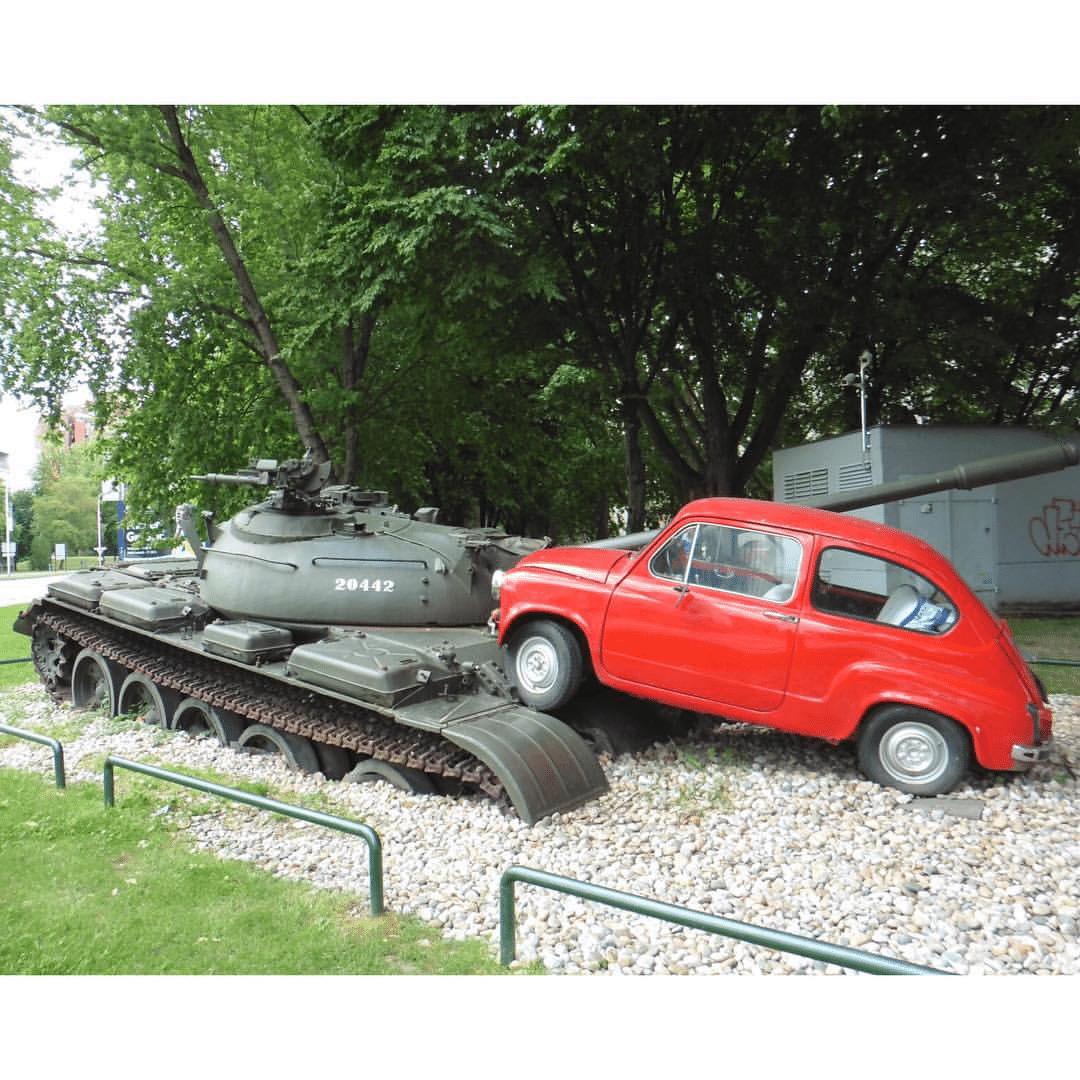Packing the bike this morning to leave Osijek, we felt like celebrities,as the owner of the sobe was busily snapping photos of us. We’re not sure whether he gets too many motorcycle travelers.
After only spending just the one night in Osijek as a transit stop we realised we could’ve spent much more time in the area but that will have to wait until next time.
Red Fica Osijek

The route out of the city took us through areas filled with lots of old Austrian style buildings and past the Red Fica monument who’s history we wrote about yesterday. Eventually we cleared the city and started heading through the countryside. Around Osijek the countryside is really flat with wheat fields stretching out as far as the eye can see. The occasional field of potatoes and corn add contrast to the sea of wheat. Around the area there were lots of people out working in the fields, either on tractors or chipping weeds.
The road passed through a few towns which consisted of only the one row of houses fronting the highway. Most of the houses were just simple one storey bungalows. Many of which were painted in shades of colours which you’d never see outside the pages of a paint catalogue. If you’d live in this area you wouldn’t bother telling people your house address. You’d simply tell them the colour of your house and they’d be sure to find it.
As we hadn’t eaten we stopped off at a small town cafe for breakfast. The cafe was packed with local blokes who were having their morning tea break so the girl running the cafe was flat out running back and forth delivering coffee. She gave us the look of distress when we ordered cooked food to accompany our coffee. Then scurried away to the kitchen to warm the hot plate up. While we were waiting it was nice just watching the activity around the town.
Along the main road timber jinkers piled high with freshly cut logs roared by on their way to the sawmill. Nearby ladies sold seedlings at a corner stand, and blokes sat around local cafe’s. Along the road little red ITM tractors trundled along. It showed the slow pace of the farming community.
Getting back on the road we passed through lots of flat country with similar small towns. Many of them had stork nests on special platforms built on top of electrical poles. Instead of being one horse towns we began to think that people describe some of the towns by the number of storks they had. The most we counted in one town was thirteen so it was a major metropolis. Around Mikleus the countryside started changing with blue hills in the distance, then as we got closer small hills and valleys.
At Virovitica we headed towards Čazma before turning off onto a tiny road to Podgarić. The road led us through farmland surrounded by tree covered hills. Along the road we spotted a few mud brick houses and half timbered houses. The outbuildings were built in timber with gaps in the timber to allow for wind to pass through the timbers.
Podgarić Monument

Arriving at Podgarić we suddenly were confronted by the monument we had come to see. Rising like some weird spaceship flying just above the hills the concrete monstrosity known as The Monument to the Revolution of the People of Moslavina is one of Dušan Džamonja’s best known works. In the years after World War II, President Tito ordered the construction of monuments across Yugoslavia to commemorate the victory of the partisans. Many weren’t just simple statues but rather sculptures of massive proportions. These days most have fallen into disrepair due to people distancing themselves from Yugoslavia. However grand these monuments are it’s still hard to decipher what the sculpture actually means and what’s it’s relationship to actually commemorate the fallen soldiers.

We stopped off at the lake below the monument for a coffee at the restaurant which raised a few eyebrows. Obviously they don’t see too many grey haired bikers around here. It was a nice spot and as we looked across the lake to the monument on the top of the hill surrounded by wheat fields and farms, we wondered why they situated it here in the middle of nowhere.
With a crowd of curious onlookers we boarded the bike and headed over the hills towards the main road into Zagreb. As we reached the outskirts of the city we took a detour through the outlying suburbs and discovered a whole area of old wooden houses. They were a mixture of one and two storey bungalows sometimes surrounded by a skirt of wood about two metres off the ground and jutting out about a meter or so. It was unusual and the only conclusion to its use would be maybe to store fire wood underneath.
After a fairly quick trip from Osijek, we were soon arriving at our couch-surf on the outskirts of Zagreb where we met Annie, our host. After settling in we chatted long into the night about life in Zagreb. Tomorrow we will leave the bike and explore Zagreb.






